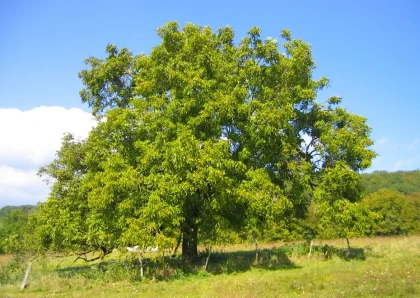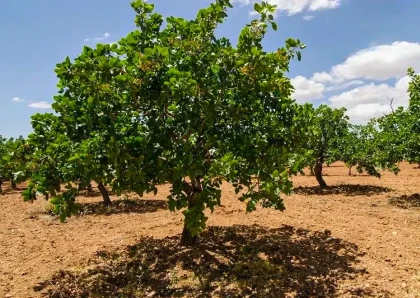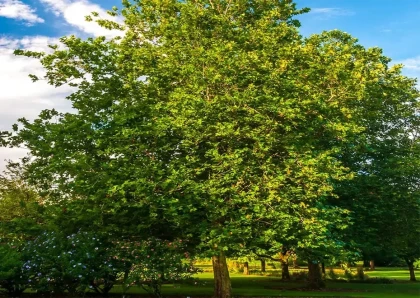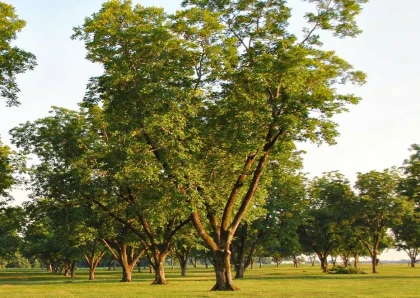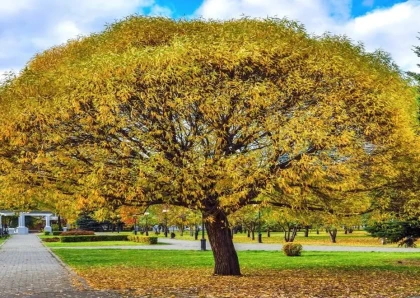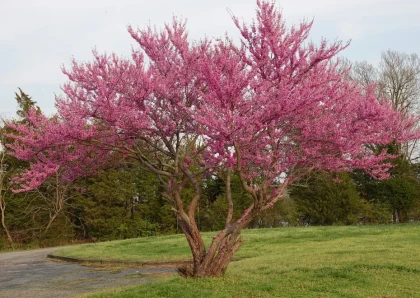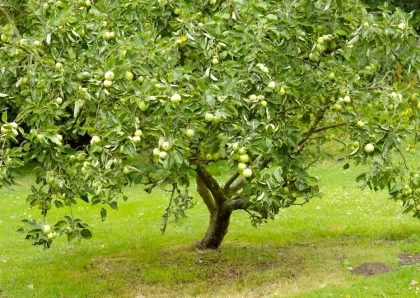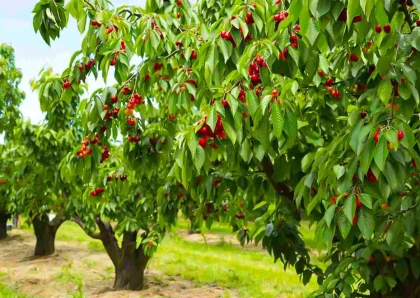
Hardy Giant Pecan Tree
Overview
History of the Tree
The Hardy Giant Pecan Tree, scientifically known as Carya illinoinensis 'Hardy Giant,' is a remarkable pecan tree variety with a rich history. It originated from the native pecan trees of North America and was selected for its exceptional hardiness and large, flavorful nuts. The Hardy Giant Pecan Tree is highly valued among pecan enthusiasts and commercial growers.
Detailed Description of the Tree
The Hardy Giant Pecan Tree is a deciduous tree known for its impressive size and robust nature. It can reach a height of 70 to 100 feet (21 to 30 meters) with a spread of 40 to 70 feet (12 to 21 meters). The tree has a broad, spreading canopy with lush green foliage that turns golden-yellow in the fall.
One of the most notable features of the Hardy Giant Pecan Tree is its large nuts. The pecans are characterized by their size, typically ranging from 1 to 2 inches (2.5 to 5 centimeters) in length. They have a rich, sweet flavor and a high oil content, making them highly sought after for culinary use.
Types of This Tree
The Hardy Giant Pecan Tree belongs to the Carya illinoinensis species and is a specific cultivar within the pecan tree family. It is known for its large and flavorful nuts, as well as its excellent adaptability to various climates.
Importance of This Tree
The Hardy Giant Pecan Tree holds several important qualities:
- Large and Flavorful Nuts: The pecans produced by the Hardy Giant Pecan Tree are known for their impressive size and exceptional flavor. They are perfect for both snacking and culinary use, adding a delicious nuttiness to a variety of dishes.
- Hardiness: As the name suggests, the Hardy Giant Pecan Tree is highly resilient and can withstand harsh weather conditions, including cold temperatures. Its ability to thrive in diverse climates makes it a valuable pecan variety for growers in various regions.
- Productivity: The Hardy Giant Pecan Tree is known for its productivity, yielding a substantial harvest of large nuts. Its high nut-to-shell ratio and excellent flavor make it a popular choice among commercial growers.
How to Care for This Tree
Proper care is essential to ensure the health and productivity of the Hardy Giant Pecan Tree:
- Plant the tree in a location that receives full sunlight, as pecans require at least 6 to 8 hours of direct sunlight daily for optimal nut production.
- Ensure the soil is well-drained and fertile, as pecan trees thrive in deep, loamy soil. Conduct a soil test to determine any necessary amendments.
- Water the tree deeply and regularly, especially during periods of drought. Provide enough water to keep the soil consistently moist but not waterlogged.
- Apply a layer of organic mulch around the base of the tree, extending to the drip line. Mulch helps conserve moisture, suppress weeds, and regulate soil temperature.
- Prune the tree during the dormant season to remove dead or diseased branches, improve airflow, and maintain its shape. Avoid heavy pruning, as pecans bear fruit on previous year's growth.
- Fertilize the tree annually with a balanced fertilizer specifically formulated for pecans. Follow the manufacturer's instructions and apply the fertilizer in early spring before new growth begins.
Benefits of the Tree
The Hardy Giant Pecan Tree offers several benefits:
- Large Nut Size: The pecans from the Hardy Giant Pecan Tree are renowned for their impressive size. They provide a generous yield of large nuts, ideal for baking, cooking, and snacking.
- Flavorful and Nutritious: The nuts of the Hardy Giant Pecan Tree have a rich, sweet flavor and are packed with healthy fats, protein, fiber, and essential nutrients like vitamin E and magnesium.
- Ornamental Value: Apart from its edible nuts, the Hardy Giant Pecan Tree adds ornamental value to landscapes with its majestic size, attractive foliage, and golden fall color.
How to Plant This Tree
Follow these steps to successfully plant a Hardy Giant Pecan Tree:
- Choose a planting location that provides full sunlight and has well-drained soil.
- Dig a hole that is wider and deeper than the tree's root ball.
- Place the tree in the hole, ensuring that the bud union or graft union is above the soil line.
- Backfill the hole with soil, gently firming it around the roots to remove air pockets.
- Water the tree thoroughly after planting and continue to water regularly, especially during the first year, to promote root establishment.
Different Types of Wood Products That Can Be Made From
The wood of the Hardy Giant Pecan Tree is highly valued for its strength, durability, and attractive grain patterns. It is commonly used in fine woodworking, furniture making, cabinetry, flooring, and decorative items. The wood's natural beauty and resilience make it a prized material for various woodworking projects.
Cons
While the Hardy Giant Pecan Tree offers numerous advantages, there are a few considerations to keep in mind:
- Size and Space Requirements: The Hardy Giant Pecan Tree is a large tree that requires ample space in the landscape. Ensure proper spacing to accommodate its size at maturity and to facilitate airflow and sunlight penetration.
- Pollination: Pecan trees, including the Hardy Giant variety, are wind-pollinated and require cross-pollination with another compatible pecan variety for optimal nut production. Planting at least one other pecan tree nearby is necessary.
- Pest and Disease Management: Pecan trees can be susceptible to various pests and diseases, including pecan scab and pecan weevil. Regular monitoring, cultural practices, and timely treatments are essential to prevent and manage these issues.
FAQs
Q: How long does it take for the Hardy Giant Pecan Tree to bear nuts?
A: The Hardy Giant Pecan Tree typically begins to bear nuts after 6 to 8 years of growth, although it can vary depending on growing conditions and tree health.
Q: What is the best time to harvest pecans from the Hardy Giant Pecan Tree?
A: Pecans are generally harvested in late fall when the husks split open, revealing mature nuts. It's important to monitor the tree and harvest the nuts promptly to avoid pest damage or nut drop.
No listings available
Related Products
Early Elberta Peach
Early Elberta Peach is a highly sought-after peach tree variety that stands out for its remarkable taste and ability to yield fruit earlier than...
Kwik-Krop Walnut Tree
History of the Tree The Kwik-Krop Walnut Tree has a rich history that dates back many decades. Developed by renowned horticulturist Dr. John A....
Famosa Pistachio Tree
History of the Tree The Famosa Pistachio Tree, scientifically known as Pistacia vera 'Famosa,' is a revered variety of pistachio tree with a fascinating...
Columbia Sycamore Tree
Certainly! The Columbia Sycamore Tree (Platanus x acerifolia 'Columbia') is a majestic and highly sought-after deciduous tree. It is a hybrid of the American...
Barcelona Filbert Hazelnut Tree
History of the Tree The Barcelona Filbert Hazelnut Tree, also known as Corylus avellana 'Barcelona,' is a popular cultivar of the European hazelnut tree....
Pawnee Pecan Tree
History of the Tree The Pawnee Pecan is a notable pecan tree variety that was developed by researchers at the USDA Agricultural Research Service....
Globe Navajo Willow Tree
The Globe Navajo Willow Tree, scientifically known as Salix matsudana 'Navajo,' is a popular deciduous tree known for its unique and appealing characteristics. This...
Eastern Redbud
The American Redbud Tree (Cercis canadensis) is a charming and versatile deciduous tree that is native to eastern North America. It is widely admired...
Granny Smith Apple Tree
History of the Tree The Granny Smith Apple Tree is a renowned apple variety that originated in Australia in the 1860s. It was discovered...
Benton Sweet Cherry Tree
History of the Tree The Benton Sweet Cherry Tree is a modern cherry variety developed through extensive breeding and selection. It was introduced by...
Questions & Answers
What do you want to know about this product?
Reviews (5)
PecanPro88
Nut Lover's Dream
The Hardy Giant Pecan Tree in my orchard never fails to impress. Its large and flavorful nuts make it a must-have for any nut lover
HarvestMaster22
Abundant Harvests Every Year
I'm amazed by the productivity of my Hardy Giant Pecan Tree. It consistently yields abundant harvests of large and delicious nuts. A true gem!
NutCrackingExpert55
Nutty Goodness Galore
The Hardy Giant Pecan Tree never disappoints. Its nuts are top-notch, and the tree's sturdy growth adds charm to my orchard. A nutty delight!
NutEnthusiast99
A Nut Grower's Paradise
I've been growing the Hardy Giant Pecan Tree for years, and it never ceases to impress. The tree's hardiness and flavorful nuts make it a true paradise for nut growers.
PecanObsessed77
A Nuttastic Experience
The Hardy Giant Pecan Tree has surpassed my expectations. Its nuts are exquisite, and the tree's majestic presence adds beauty to my orchard. A nuttastic experience indeed!





